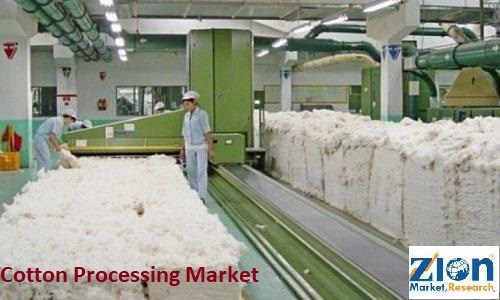Soft Power Economics: Examining the Economic Impact of Cotton Processing Industry
Cotton Processing Market Size / Numbers
The global market for cotton processing witnessed a significant valuation of approximately $80.43 billion in 2022. Experts anticipate a remarkable surge in its worth, projecting it to reach approximately $128.81 billion by the year 2030. This growth trajectory is expected to be fueled by a robust compound annual growth rate (CAGR) of approximately 7.5% between the years 2023 and 2030.
Cotton Processing Overview:
The transformation of raw cotton fiber into finished goods is the ultimate goal of the cotton processing step, which is an essential part of the textile and clothing manufacturing process. The tasks of ginning, spinning, weaving, and finishing are included in this process.
Request Free Sample Report – https://www.zionmarketresearch.com/sample/cotton-processing-market-size
The following is an outline of the primary steps involved in cotton processing:
Ginning: The first step in the production of finished cotton is called “ginning,” and it consists of cleaning and separating raw cotton from its seeds and other contaminants. Cotton gins are the machines that are used to perform the process of mechanically separating the cotton fibers from the cottonseed.
Spinning: After the cotton fibers have been washed and combed, they are put through a spinning machine to create yarn. The fibers are twisted together in the process of spinning, which results in the creation of strong, continuous threads. For both weaving and knitting, yarns are an essential type of raw material.
Weaving and Knitting: Fabrics are created via the weaving and knitting processes, and yarns are an essential component of each of these operations. Knitting entails making loops of yarn, which are then woven together to produce fabric, whereas weaving requires the strands to be woven together in a certain pattern.
Finishing: Fabrics are frequently put through finishing operations after they have been knitted or woven in order to enhance their appearance, feel, and overall performance. Treatments such as dying, printing, and even softening the fabric might be included in the finishing process.
Analysis of Current Market Trends and Insights
Technological Advancements: Improvements in Automation, Machinery, and Processing Methods The cotton processing sector has witnessed improvements in the areas of automation, machinery, and processing methods. Efficiency and quality have both been increased with the introduction of modern ginning machines, spinning equipment, and finishing processes.
Sustainability: The cotton processing sector, along with the textile industry as a whole, has begun to place a substantial emphasis on the concept of sustainability. The number of people who use less water, less energy, and less chemicals is growing, and so is the number of people who support these initiatives. The cultivation of cotton using organic and environmentally responsible methods is also gaining popularity.
Enhancement of Product Quality: One of the primary focuses of modern cotton processing has been the improvement of the final products’ overall quality. Cotton fibers of a higher grade result in yarn and fabric with superior characteristics, which in turn results in improved final products.
Supply Chain Transparency: Transparency in the Supply Chain Consumers are becoming more concerned about the sources of their products and the processing that goes into making them. Because of this, there has been a drive for increased supply chain transparency, which includes the ability to trace cotton all the way from its origin to the end product.
Digitalization: The incorporation of digital technology such as data analytics, the Internet of Things (IoT), and artificial intelligence into cotton processing activities in order to increase overall efficiency, optimize existing procedures, and keep track of all of the machinery involved.
Global Market Dynamics: The dynamics of the worldwide market have an effect on the cotton processing sector, which is affected by factors such as the levels of global cotton production, the rules governing trade, and the demand of consumers for textiles and apparel. Alterations in international trade agreements, fluctuations in cotton prices, and adverse weather that affects cotton production are all potential factors that could have an effect on the sector.
Regional Variations: Cotton processing is a global industry, with important production and processing hubs in countries such as China, India, the United States, and others. Regional Variations Cotton processing is a global industry. It is possible for different locations to have significantly different degrees of technology innovation, labor prices, and regulatory regimes that are relevant to the sector.
Consumer Preferences: Preferences of Consumers Customers’ preferences for environmentally friendly and ethically made items have led to a rise in interest in organic cotton and transparent supply chains. Brands and manufacturers that are able to match themselves with these tastes typically get an advantage in the marketplace.
Request For Customized Report – https://www.zionmarketresearch.com/custom/7432
Cotton Processing Market: Competitive Analysis
The cotton processing market is dominated by players like:
- Toyota Industries
- G.B. Enterprises
- Suryalakshmi Cotton Mills
- Lummus Corporation
- Shree Giri Cotton Industries
- Nipha Exports Private Limited
- Bajaj Group of Companies
- Shandong Swan Cotton Industrial Machinery Stock Co.
- Cherokee Fabrication
- Rieter.
Cotton Processing Market: Challenges
The following are some of the difficulties that the cotton processing market has encountered in the past and may continue to encounter in the future. It is important to note that the circumstance may have changed since then; therefore, I suggest that you consult more recent sources in order to obtain the most up-to-date information.
Fluctuating Cotton Prices: Cotton Price Swings The cotton business is frequently impacted by swings in cotton prices that are both volatile and unpredictable. These swings in cotton prices are caused by a variety of variables, including meteorological conditions, supply-demand mismatches, and trends in the global economy. These shifts have the potential to have an effect on the profit margins of enterprises that process cotton.
Supply Chain Disruptions: Disruptions in the Supply Chain The cotton processing business is dependent on a global supply chain that is both complicated and extensive. This network includes manufacturers of equipment, suppliers of raw materials, and transportation services. Delays and increased costs can result from the supply chain being disrupted anywhere along its length, whether by natural disasters or by geopolitical conflicts, for example.
Environmental Problems: The processing of cotton requires the use of chemicals, water, and energy, all of which have the potential to cause problems for the environment. The business sector is under increasing pressure to embrace more environmentally responsible practices and to limit the impact it has on the environment. It can be tough to implement these changes while still preserving efficiency.
Labor Costs and Availability: Costs of Labor and the Availability of Workers The cost of labor and the number of workers available can vary dramatically between areas. It can be difficult to find qualified labor for certain phases of cotton processing, such as ginning and spinning, but these processes are essential to producing high-quality yarn. Although automation and mechanization are frequently thought to be solutions, the installation of these technologies typically requires a large financial investment.
Competition from Synthetic Fibers: Cotton is up against competition from synthetic fibers like polyester, which has several characteristics that cotton does not, including resistance to wrinkling, durability, and the capacity to drain away moisture. It’s possible that the rise in the popularity of synthetic fibers will have an effect on the demand for products made from cotton.
Consistency in Quality: Keeping the quality of the cotton fiber consistent can be difficult due to the changes in cotton crops, growing circumstances, and ginning processes. Both the functionality and the aesthetics of the finished product can be negatively impacted by inconsistencies in the quality.
Market Access and Commerce Barriers: The regulations and tariffs that govern international commerce can have an effect on the flow of cotton and cotton products across international borders. Supply chains can be disrupted and market access might be limited when there are trade barriers and regulatory constraints.
Technology Adoption: Adoption of New Technologies Although technological advances present prospects for increased productivity and quality, it is not always easy to accept new technologies due to considerations such as cost, the need for training, and people’s natural reluctance to change.
Consumer Preferences for Sustainable Products: Preferences of Consumers for Sustainable Items Consumers are becoming more concerned about the environmental and ethical elements of the items they purchase. This has led to an increase in the demand for sustainable products. In order to satisfy these preferences, investments in environmentally responsible and morally responsible business practices are required throughout the supply chain of cotton processing.
Rising Energy Costs: Costs of Energy on the Rise The production of cotton takes a large amount of energy at each stage, from ginning through finishing. The ever-increasing price of energy can have an effect on the operating costs of processing facilities.
Traceability and Transparency: The drive for transparency in supply chains has led to calls for the traceability of cotton from its origin all the way to the product it will eventually become. It may be difficult to provide this level of traceability, particularly in supply chains that are extensive and global in scope.
It is essential to keep in mind that the difficulties encountered by the cotton processing market can range from one place to another, depending on the level of technological development and the shifting preferences of consumers. I highly recommend consulting industry papers, news sources, and specialists in the sector for the most up-to-date information on the problems affecting the cotton processing industry.
FREQUENTLY ASKED QUESTIONS
- What is Cotton processing?
- Which key factors will influence the cotton processing market growth over 2023-2030?
- What will be the value of the cotton processing market during 2023-2030?
- What will be the CAGR value of the cotton processing market during 2023-2030?
- Which region will contribute notably towards the cotton processing market value?
- Which are the major players leveraging the cotton processing market growth?





